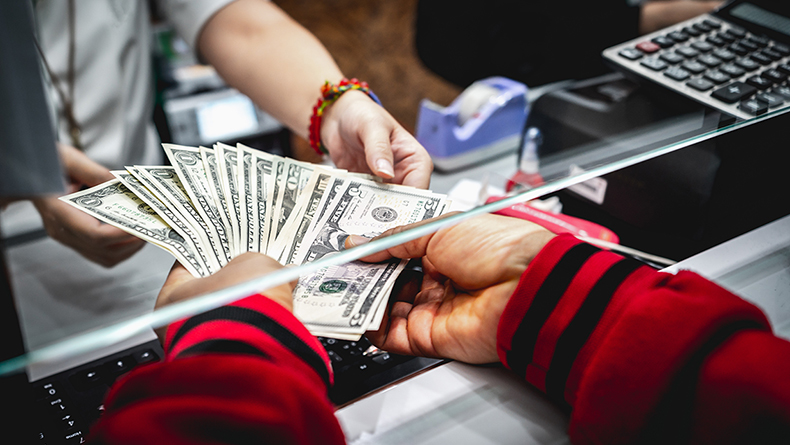AARP Hearing Center
Banking After COVID: Emerging Gaps in Financial Access
By Joe Valenti , April 21, 2021 12:24 AM

As millions receive their federal stimulus payments, some may encounter extra hassle accessing their funds, including the 3.1 million households headed by someone age 50 or older who do not have an account at a bank or credit union. This group of older adults are among those generally known as the unbanked, which is just one category of people who are financially underserved.
Not having a bank account means taking on a greater burden for everyday financial services: paying higher fees, risking cash and checks being lost or stolen, and lacking a safe way to save. Without convenient access to make electronic payments, older adults are also excluded from opportunities such as online shopping for groceries and essentials. Meanwhile, even older adults with bank accounts face new challenges as financial services increasingly move online and some bank branches remain closed.
Every two years, the Federal Deposit Insurance Corporation (FDIC) conducts a national survey of banking habits—and last September, AARP published a report analyzing findings from the 2017 survey. Meanwhile, late last year the FDIC released its next round of data, from 2019, and, while the information still pre-dates the pandemic, it nevertheless offers implications to consider for older adults moving forward, providing the opportunity to build on takeaways from our previous report. Those implications include disparities in who holds bank accounts—and who doesn’t—as well as how people manage their accounts.
More Older Adults Banked, But Disparities Remain
Between 2017 and 2019, the number of unbanked households headed by someone 50+ fell from 3.5 million to 3.1 million. (For measurement purposes, all age-based statistics in this study reflect the age of the household head.) Consistent with prior surveys, older adults were more likely to have bank accounts than younger ones: 4.4 percent of the 50+ were unbanked, compared to 6.2 percent of households in the 25-49 age group.
Yet, major disparities remain among the 50+: 13 percent of 50+ African American/Black households and 11 percent of Hispanic/Latino households had no checking or savings accounts at all, compared to only 2 percent of White and Asian households in this age group. Meanwhile, due to sample size limitations, estimates by age are unavailable for American Indians, Alaskan Natives, Native Hawaiians, and Pacific Islanders. Historically, these groups have also had higher rates of being unbanked.
So why do millions lack accounts? Consistent with prior surveys, the main reason people give for not having a bank account is a lack of money to meet minimum balance requirements, with 35 percent of unbanked respondents age 50+ citing that obstacle. In addition, 17 percent said they do not trust banks and 7 percent claimed avoiding a bank gives them more privacy. Other factors included banks’ lack of convenience and identification requirements.
Mobile Banking Grew, While Tellers Remain Important
Even before the pandemic, older adults with bank accounts were undergoing a shift in how they banked. Between 2017 and 2019, the share of 50+ households who banked using a mobile phone at least once in the past year increased from 24 percent to 45 percent, and more than doubled among those age 65 and older. In 2019, a majority (55 percent) also used a computer or tablet for banking at least once. This suggests that comfort with electronic methods has grown.
Yet in spite of that trend, traditional means of banking remain strong among older adults. A full 77 percent of households headed by someone 50+ still relied on bank tellers for at least some transactions. Moreover, the shift toward electronic banking was relatively modest in terms of the most common way the 50+ access accounts. Tellers remained especially crucial for the 65+, with 39 percent using them most frequently, compared with only 22 percent of those in the 50-64 age group. Meanwhile, 54 percent in the 50-64 age group used online or mobile banking most frequently, while only 34 percent of the 65+ chose these as their most common access method—and primarily by using a computer or tablet, rather than a mobile phone. These findings have likely already changed somewhat, as the pandemic has led more customers toward electronic banking tools to deal with bank branches’ limitations under public health mandates.
Even pre-COVID, the number of bank branches had fallen over the past decade. And, of course, many branches shuttered at least temporarily during the last year, and so it will be worth monitoring how branches reopen, and what this means for communities. As noted in a profile on the town of Duncan, Arizona early last year after the town lost its only bank, “Many senior citizens, especially those uncomfortable with digital banking, have felt an outsize impact. The absence of a bank branch in Duncan also makes it harder to attract new residents.” The future role of branches will be a key question for banks and policymakers alike.
Some answers may come late next year with the release of the FDIC’s 2021 survey results. In the meantime, it is clear that more work needs to be done to ensure safe and affordable financial services are available to everyone.
































































